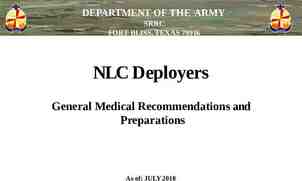Move it or Lose it: The Benefits of Movement and Exercise in
20 Slides144.25 KB

Move it or Lose it: The Benefits of Movement and Exercise in Traumatic Brain Injuries Carrie DeNiel, PT, DPT Senior Physical Therapist Outpatient Neurology Physical Therapy Hennepin County Medical Center

Objectives: Participants will understand common symptoms and impairments that physical therapists treat in patients who have had a traumatic brain injury. Participants will be able to list three benefits of early intervention and exercise to those who have sustained a traumatic brain injury. Participants will be able to demonstrate 2 common exercises completed in physical therapy during treatment of a patient who has had a traumatic brain injury.

What is a traumatic brain injury (TBI)? (1,2,4) Multiple causes (bump, blow, jolt or penetrating head injury) Disrupts normal function of the brain Not all hits to the head result in a TBI Range of severity – Mild (i.e., a brief change in mental status or consciousness) – Severe (i.e. an extended period of unconsciousness or memory loss after the injury)

Mild traumatic brain injuries Common causes: – Falls – Vehicle-related collisions – Violence – Sports injuries – Explosive blasts and other combat injuries Common symptoms – Physical – Behavioral/emotional – Cognitive (1,2,4)

Outpatient treatment of mild TBIs Collaboration of an interdisciplinary team Physical Medicine and Rehabilitation physicians Neuropsychologist Clinical Psychologist Developmental optometrist Nurse practitioners, Physician Assistants Audiology / Vestibular specialists Therapeutic recreation Occupational Therapists Nurse coordinators Speech Language Pathologists Social Workers Physical Therapists (3)

Common symptoms of mild TBI (2,4,5) Physical Behavioral/Emotional Cognitive Sleep Headache Drowsiness Feeling “slowed down” Sleeping more than usual Nausea Fatigue/lethargy Feeling “in a fog” or “dazed” Sleeping less than usual Vomiting Irritability Difficulty concentrating Trouble falling asleep Blurred or double vision Depression Difficulty remembering Seeing stars / lights Anxiety Balance problems Sleeping more than usual Dizziness Difficulty falling asleep Sensitivity to light or noise Tinnitus (ringing in the ear)

Common symptoms that physical therapists treat in patients with mild TBI Headaches Neck pain Balance problems Motion sensitivity Visual deficits Dizziness Fatigue Deconditioning Poor tolerance to activity

What are functional limitations associated with persistent symptoms of a mild TBI? Anything that limits a person’s abilities to complete normal activities, return to work or return to sport such as: – pain – difficulty turning their head – difficulty moving in bed, standing, sitting, or walking – falls or near falls – poor tolerance to a household activity (making meals, cleaning, shopping, walking) – poor tolerance to aerobic activity (running, jumping, turning quickly) – inability to tolerate busy places

Why is early mobilization after a mild TBI with a physical therapist important? People need to get moving! – prolonged rest can lead to fatigue, reactive depression, and physiological deconditioning (11) – most mild TBIs resolve themselves within 7 to 10 days, up to 3 months for non-athletes (6,7,8) – people are able to and should exercise despite having persistent symptoms with the assessment and guidance of a physical therapist (6,7,8,9) quantitative, individualized, and progressive subsymptom threshold aerobic exercise rehabilitation (9) improved symptom resolution compared to strict rest (10)

Benefits of early intervention and exercise Cardiovascular system Sleep Pain Fatigue Cognition Psychiatric conditions (8)

Exercise benefits and the cardiovascular system Increases the body’s relaxation response (parasympathetic) that helps to regulate elevated heart rate and blood pressure (8, 12, 13) Increases blood flow to the brain (13) Improved endurance and fitness after completing light and high resistance weight training as well as long duration aerobic exercise (8,14,15)

Exercise benefits and sleep Moderate intensity exercise improved self-reported sleep quality scores in a study of older adults (8,16) In healthy army recruits, aerobic exercise improved – Sleep onset latency – Sleep efficiency – Decreased wake time during sleep (8,17)

Exercise benefits on cognition and fatigue Reduction in fatigue after endurance conditioning noted in studies of patients with cancer and multiple sclerosis (8,18,19,20,21) Increased blood flow to the brain which aids in improved cognitive performance (13,22,23) Associations of exercise and cognition in older adults and the elderly (8) – decreased brain tissue loss – lowering risk of dementia, Alzheimer’s disease – delayed onset of age-related decline in brain function (24) (25) (26)

Exercise benefits on psychiatric conditions Regular aerobic exercise associated with decreased incidence of depression and anxiety disorders (8,27) Improved mood and emotion in patients with a TBI (8,28)

Long-term benefits of exercise after sustaining a mild TBI Improved quality of life Prevention of chronic disease that is associated with a sedentary lifestyle Maintain and progress physical work capacity Maintain and progress level of endurance and balance Manage and/or reduce levels of fatigue and stress Reports of improved self-esteem and less depression Reports of improved social participation (29) (8) (8,30) (8,30, 31) (8,30) (29,31) (29,31)

Suggestions for a life long exercise program Walking program –15-20 minutes, 4-5 days a week Bicycle Body weight exercises –Squats –Lunges –Arm and leg lifts Completed in standing, sitting, laying down, or on hands and knees Weight lifting Free / low-cost exercise groups Personal training / accountability group Community centers

Common exercises completed with PT Aerobic – walking program Head and neck – looking side to side, up and down Strength and endurance – squats – bicep curls and shoulder press Balance – feet together (eyes open, eyes closed)

Questions?

References 1. 2. 3. 4. 5. 6. 7. 8. 9. 10. 11. 12. 13. 14. 15. Traumatic Brain Injury and Concussion. (2016, September 20). Retrieved March 02, 2017, from https:// www.cdc.gov/traumaticbraininjury/get the facts.html Hennepin County Medical Center. (n.d.). Things to Look For After You Hit Your Head [Brochure]. Minneapolis, MN: Traumatic Brain Injury Center. Traumatic Brain Injury Outpatient Program [Pamphlet]. (2015). Minneapolis, MN: Hennepin County Medical Center. Traumatic Brain Injury. (2012, June 19). Retrieved March 14, 2017, from http:// www.moveforwardpt.com/SymptomsConditionsDetail.aspx?cid 0ed75eb1-1d47-41a1-98da-795289c0c02a O. (2013, September). Guidelines for Concussion / Mild Traumatic Brain Injury & Persistent Sympmtoms [Second Edition, for adults (18 years of age)]. Toronto, ON, Canada. 2017, E. R. (2017, March). Beyond Rest: Physical Therapists and Concussion Management. Retrieved March 17, 2017, from http://www.apta.org/PTinMotion/2017/3/Feature/BeyondRest/ Mccrory, P., Meeuwisse, W., Aubry, M., Cantu, B., Dvorak, J., Echemendia, R. J., . . . Sills, A. (2013). Consensus Statement on Concussion in Sport—the 4th International Conference on Concussion in Sport Held in Zurich, November 2012. Clinical Journal of Sport Medicine, 23(2), 89-117. doi:10.1097/jsm.0b013e31828b67cf Mossberg KA, Amonette WE, Masel BE. Endurance training and cardiorespiratory conditioning after traumatic brain injury. J Head Trauma Rehabil. 2010;25:173-183. Leddy, J. J., Kozlowski, K., Donnelly, J. P., Pendergast, D. R., Epstein, L. H., & Willer, B. (2010). A Preliminary Study of Subsymptom Threshold Exercise Training for Refractory Post-Concussion Syndrome. Clinical Journal of Sport Medicine,20(1), 21-27. doi:10.1097/jsm.0b013e3181c6c22c Thomas, DG, Apps JN, Hoffma RG, et al. Benefits of strict rest after acute concussion: a randomized controlled trial. Pediatrics. 2015;135(2):213-223. Willer B, Leddy JJ. Management of concussion and post-concussion syndrome. Curr. Treat. Options Neurol. 2006;8:415-26. Carter JB, Banister EW, Blaber AP. Effect of endurance exercise on autonomic control of heart rate. Sports Med. 2003;33:33-46. Doering TJ, Resch KL, Steuernagel B, et al. Passive and active exercises increase cerebral blood flow velocity in young, healthy individuals. Am J Phys Med Rehabil. 1998;77:490-493. Bhambhani Y, Rowland G, Farag M. Effects of circuit training on body composition and peak cardiorespiratory responses in patients with moderate to severe traumatic brain injury. Arch Phys Med Rehabil. 2005;86(2):268-276. Jankowski L, Sullivan S. Aerobic and neuromuscular training: Effect on the capacity, efficiency, and fatigability of patients with traumatic brain injuries. Arch Phys Med Rehabil. 1990;71:500-504.

References 16. King A, Oman R, Brassington G, Bliwise D, Haskell W. Moderate-intensity exercise and self-rated quality of sleep in older adults. A randomized controlled trial. JAMA. 1997;277(1):32-37. 17. Shapiro C, Warren P, Trinder J, et al. Fitness facilitates sleep. Eur J Appl Physiol. 1984;53(1):1-4. 18. Dimeo F, Stiegliz R, Novelli-Fischer U, Fetscher S, Keul J. Effects of physical on the fatigue and psychological status of cancer patients during chemotherapy. Cancer. 1999;85(10):2273-2277. 19. McTiernan A. Physical Activity after cancer: physiologic outcomes. Cancer Investigation. 2004;22(1):68-81. 20. Petajan J, Gappmaier E, White A. Impact of aerobic training on fitness and quality of life in multiple sclerosis. Ann Neurol. 1996;39:432-441. 21. Mostert S, Kesselring J. Effects of short-term exercise training program on aerobic fitness, fatigue, health perception and activity level of subjects with multiple sclerosis. Mult Scler. 2002;8(2):161-168. 22. Griesbach GS, Hovda DA, Molteni R, et al. Voluntary exercise following traumatic brain injury: brain-derived neurotrophic factor upregulation and recovery from function. Neuroscience. 2004;125:129-39 23. Leddy, J. J., & Willer, B. (2013). Use of Graded Exercise Testing in Concussion and Return-to-Activity Management. Current Sports Medicine Reports, 12(6), 370-376. doi:10.1249/jsr.0000000000000008 24. Colcombe S, Erickson K, Raz N, et al. Aerobic fitness reduces brain tissue loss in aging humans. J Geronotol. 2003;58A(2):176-180 25. Lautenschlager N, Cox K, Flicker L, et al. Effect of physical activity on cognitive function in older adults at risk for Alzheimer disease: A randomized trial. JAMA. 2008;300(9):1027-1037. 26. Kiraly M, Kiraly S. The effect of exercise on hippocampal integrity: review of recent research. Int J Psychiat Med. 2005;35(1):75-89 27. Goodwin R. Association between physical activity and mental disorders among adults in the United States. Prev Med. 2003;36(6):698-703. 28. Gordon W, Sliwinski M, Echo J, McLoughlin M, Sheerer M, Meili T. The benefits of exercise in individuals with traumatic brain injury: a retrospective study. J Head Trauma Rehabil. 1998;13(4):58-67. 29. Wise EK, Hoffman JM, Powell JM, et al. Benefits of exercise maintenance after traumatic brain injury. Arch. Phys. Med. Rehabil. 2012;93:1319-23. 30. Bushnik T, Englander J, Wright J. Patterns of fatigue and its correlates over the first 2 years after traumatic brain injury. J Head Trauma Rehabil. 2008;23(1):25-32. 31. Thornton M, Marshall S, McComas J, Finestone H, McCormick A, Sveistrup H. Benefits of activity and virtual reality based balance exercise programmes for adults with traumatic brain injury: perceptions of participants and their caregivers. Brain Inj 2005;19:989-1000.






